A Most Merry and Illustrated History of

George Washington
He did his best.
All right, already! We know George Washington's false teeth were not made of wood! They were made of out of ivory, bone, and yes, even real teeth. So why do we keep getting all these never-ending articles that keep correcting the "myth" about Old Hickory Teeth?
Now, when we say George's teeth were not made of wood, that doesn't mean that there were no false teeth made of wood. Wood was, after all, cheap enough (literally) to burn. Wooden teeth have been around for centuries and had been particularly favored in medieval Japan. The earliest known pair of complete dentures is a wooden set possibly made for the Buddhist priestess, Nakaoka Tei, who lived a couple of hundred years before George. But for the well-to-do Englishmen of the Georgian Era (not a joke by the way), wood was not the preferred material, and as we'll see it's more accurate to call George "Old Hippopotamus Teeth".
So what was the problem with George's teeth? After all, throughout his life George Washington remained in excellent condition. He was one of the best horsemen in the land and even as he approached old age he would himself pitch in to help with the work on his Mount Vernon farms.
But George's general robustness was punctuated by serious and at times life-threatening illnesses. When he was 19 he contracted smallpox (on a trip to Barbados with is brother Lawrence), and then he had what he called a "violent pluriese", that is, pleurisy, an inflammation of the membranes around the lungs. A few years later while on that famous military mission after he had single handedly started the French and Indian war, George suffered from headaches and dysentery, and when he took over the running of Mount Vernon he came down with dengue fever (a viral mosquito-born infection). Then as President, George had a leg infection that was in danger of becoming gangrenous and required surgery - not something to be taken lightly in the 18th century. He also complained of malaria, flu, and rheumatism, although in the latter term could refer to various generic aches and pains. His last fatal illness, for two hundred years a matter of some dispute, has been recognized as an attack of acute epiglottis. And worst of all, George had hemorrhoids.
So it should be no real surprise that George had troubles with his choppers. Now you will read on the Fount of All Knowledge that he may have had an in-born propensity for bad teeth, and it was this genetic proclivity that from his early 20's netted George a loss of about one tooth a year. Who knows? This explanation may be even be true.
On the other hand, George - although perhaps skewed a bit to the left on the normal curve in dental robustness - was in no different a boat than a lot of other people of the era. Loss of teeth was the norm and one contemporary tome mentioned that young ladies could expect to start losing their teeth after their 18th birthday. Well into the 20th century it was a given that you would eventually end up wearing dentures. Some dentists would even recommend that people in their twenties go ahead and get everything yanked and be done with it.
Today's topical anesthetics can render dentistry virtually painless. However there are those who still remember how the twice yearly visits were times of, if not sheer terror, then of considerable angst. But the trials and tribulations of the Baby Boomers as they sat in The Chair were nothing compared to the horrifying experience that was a trip to the dentist in Colonial America. In fact, in George's time there were not only no anesthetics, but there were few real dentists. That is, there were few professionals who specialized solely in the care of the teeth and this was not a good thing.
Instead, dentistry was often a sideline. Since the usual remedy for a troublesome tooth was simply to pull it, it made some sense that surgeons (who were distinct from physicians) would sometimes double as dentists. But less rationalizable (to us) is that so did barbers and even blacksmiths, for crying out loud! Even one of the most respected silversmiths in Boston - some fellow named Paul Revere - did double dental duty. And there is the story that Charles Wilson Peale, who painted George's portrait at least twice, once crafted a set of those famous non-wooden dentures.
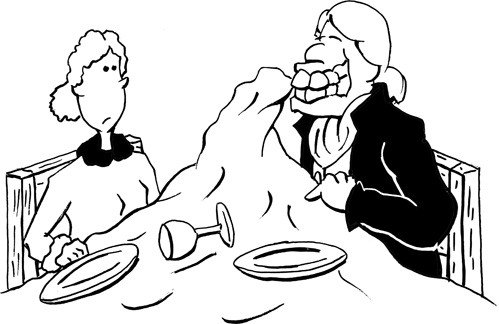
George's care must have been perfunctory.
As a young man, George did include some advice for oral hygiene in his famous Rules of Civility and Decent Behavior. This advice, though, was mostly what you should not do. Don't, he said, clean your teeth while sitting at a table and using your napkin or the tablecloth. Nor should you rinse out your mouth in the presence of others. But that's about it. All in all, as a young man George's dental care must have been pretty perfunctory.
Others of George's personal habits were not such that would promote healthy teeth. Among his favorite foods were walnuts and from all accounts George literally ate them by the bushel. As commander of the Continental Army, he kept barrels of them for himself and his guests, and visitors noted that after dinner George would sit conversing for hours while he scarfed down the walnuts.
Of course walnuts come in shells which are as hard as - well, as hard as walnuts. Mechanical nutcrackers have always been around, but true nut aficionados can break the shells with aplomb by pressing them against each other. Of course, you should never use your teeth to crack nuts of any kind.
But that's what George did. Or at least one of the more commonly found (and always unreferenced) stories is that George confided to His Rotundity, John Adams, that he, George, used to cracked Brazil nuts with his teeth and that's why in his last years George had to gum his soft breakfast wheat cakes. It would be nice if someone would publish a proper reference for John's comment (you also never get a source for the story that just before crossing the Delaware George told Henry Knox to "Shift that fat ass, Harry, but slowly, or you'll swamp the damned boat"). Likely, though, the gist of John's story is true enough, and George's fondness for nuts from the shell is what began his lifelong struggle with his teeth.
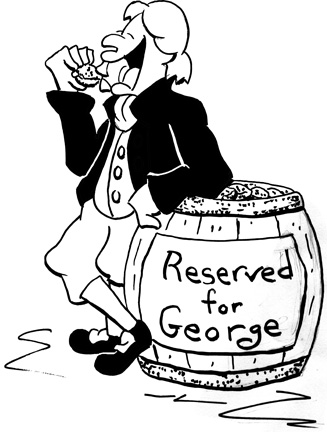
George's Favorite
There is, though, plenty of primary source material about George's dental woes. When he was only 24 he wrote in his diary that he asked a "Doctr Watson" to pull a tooth that had been giving him trouble. The cost was 5 shillings. That was also the cost of bottle of good English claret.
George's half-brother, Lawrence, died in 1752 and willed Mount Vernon to George with the proviso that he couldn't take complete ownership while Ann (née Fairfax), Lawrence's widow, was still alive. What George did, though, was to speed things up by leasing Ann's interest in the farm. That way for all practical purposes he could run the farm as if it was his. When Anne died in 1761, George finally became the sole owner.
At Mount Vernon George lived the life of a gentleman farmer. He was also an innovative agriculturalist. He introduced new crops that would not deplete the soil, started a fishery, and generally improved the land.
But George didn't improve his teeth. In 1760, one of his fellow Virginia militiamen, Captain George Mercer, mentioned that during the few times that George didn't keep his mouth shut, you could notice some "defective" teeth. By 1772, George had to call in Dr. John Baker (who was actually a physician). Dr. Baker, who pulled several of George's teeth, tried to get George to brush his teeth better and from what we read George did his best. But brushing won't save already decaying teeth or reverse bone loss from your jaw. The dental bills were by no means cheap, either. From March 1772 to November 1773, George paid John £14 6s. Although it is almost impossible to put a dollar figure on colonial currency, this can be thought of as about $1000 in today's money.
So when George took control of the Continental Army in 1775, he was 43 and already missing several teeth. By then John had moved to Philadelphia - then the most important city in the colonies - and continued to advise George. Since it was already known that dental gaps could lead to shifting and misalignment of healthy teeth, George was fitted with bridges or partial dentures which were wired into place.
Doing dentistry by correspondence - particularly during wartime - had its own hazards. On May 29, 1781, one of George's messages to John was intercepted by the British. This not only gave the British the name of a "rebel" dentist (whom they could now spy on), but from the return address they could pinpoint the location of George's headquarters as New Windsor, New York. Of course since George was in New York, perhaps the British should intensify their action in the South where Lord Charles Cornwallis and his army were near that place called Yorktown. After all, with George's teeth causing so many problems, he wouldn't be traveling much, would he?
In five months, it was all over.
But not George's dental problems. He kept writing John and other dentists for brushes and scrapers to clean his teeth. We also know he ordered cleaning solutions made from who-knows-what concoction. One brand he had used at Mount Vernon (imported from England no less) was called Greenough's Tincture (which came with sponge brushes). This shouldn't be confused with the familiar tincture of iodine available today since iodine wasn't discovered until 1811. Instead Greenough's Tincture was a mouthwash made from alum (potassium aluminum sulfate), bitter almond (Prunus dulcis), logwood (Haematoxylum campechianum), orris root (from Iris germanica and Iris pallida) all extracted into alcohol.
Although Cornwallis surrendered to George in 1781, the war didn't end until 1783. So George had to stay away from Mount Vernon for two more years. But that didn't mean his teeth were any better. In 1782 he wrote to Lund Washington, a distant relative who had been managing Mount Vernon in George's absence, and who had much to George's chagrin sent some "refreshments" to a British ship when it anchored offshore. Would Lund, George ask, send him the teeth that he kept locked up in his desk drawer? If these teeth were ever used - and they had been sitting in the desk for at least seven years - they must have gone in to making partial dentures or bridges. Although implants were known at the time, George had little hope they would take hold at his age.
One thing that has disturbed some people is that not just that some of George's false teeth were actually real human teeth, but that some of the teeth were from his slaves. We don't know if these were teeth that the slaves had pulled because they had their own dental problems, if the teeth had simply fallen out, or if they were healthy teeth that the slaves pulled just so George could have them. But at least George did pay the slaves (an average of 13/6 per tooth), and though this seems a bit ghoulish to us, using human teeth for dentures and implants was commonplace. Teeth would even be removed from corpses for later sale.
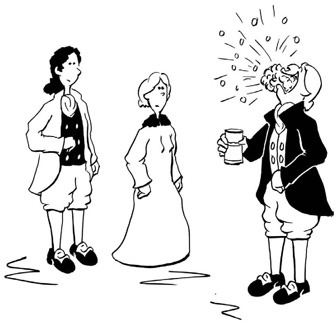
George advised against rinsing the mouth
(in the presence of others).
We also know that George wasn't above using government officials to help him fix personal matters (such as when he asked Secretary of the Treasure, Oliver Wolcott, Jr., to help kidnap a runway teenage slave girl), and such matters extended to his teeth. In 1783, he wrote to Lt. Col. William Stephens that he had heard good things about the French dentist, Dr. Jean-Pierre Le Mayeur (or some name like that). Would William, George asked, make inquiries whether Jean-Pierre merited his reputation?
William replied in the affirmative that Jean-Pierre was indeed a skilled practitioner. The drawback was he lived in British-occupied New York and had a number of high ranking British officers as his patients. These included General Sir Henry Clinton who at the time was the Commander-in-Chief of the British forces which were still nominally at war with the Americans. However, Jean-Pierre seemed to have taken offense at some snooty comments the Englishmen had made about France coming to the aid of the Americans. Jean-Pierre had responded with "warmth" and since then had aligned himself and his dental skills with the colonists.
Jean-Pierre was one of the early advocates of implantation and had even installed an implant for George's secretary, Lt. Colonel Richard Varick. But as we saw, George himself was skeptical about the effectiveness of implants particularly for someone whose jawbones had not only quit growing but by now were certainly undergoing even more bone loss.
Still George was satisfied with Jean-Pierre's work. Later they became good friends, and Jean-Pierre made several visits to Mount Vernon. He even gave a pony to George's step-grandson, George Washington Parke Custis, who later became the father-in-law of Robert E. Lee. Jean-Pierre continued his professional services with the Washington family after George died, and Tobias Lear, George's secretary at Mount Vernon, had Jean-Pierre fashion some dentures for Martha.
Compared to the services of Dr. Baker, the cost of dentures was surprisingly cheap. After the revolution, George would pay between $20 and $60 - by then the American government had its own currency - for a first class set of full dentures. Today a set goes for $2000 - $3000. Since $20 in 1791 is about $400 today, dentures were not an overly burdensome expense for someone of George's economic class.
In any case as time went on, having a dentist help with his teeth became a moot point, and George's correspondence dealt more and more with fixing his dentures. If we go by his letters to Dr. John Greenwood - who George first wrote to in 1791 - George's false teeth gave him almost as much trouble as his real ones. Dentures were made, as we said, from ivory (hippopotamus tusks were a convenient source), bone, and even real teeth, and they were fitted into bases that slipped over the gums. From time to time the individual teeth worked themselves loose, softened from saliva, or simply rotted out. George kept spare dentures around, and that way he always had a pair on hand (or in mouth) and could send the other set to John to fix.
Not all dentures were created equal, and sometimes George didn't get the best available. A dentist named James Gardette once sent him a bulky and horrible set which we presume he quickly threw out. Big dentures were an anathema to George.
One common thread that ran through George's letters to his dentists was to avoid repairs to the dentures that would make his face pooch out more than it did already. George said he thought the teeth needed to be angled in more since the outward incline tended to exacerbate the problem. Inspection of George's surviving dentures support his analysis, and it would also have been a good idea just to make the individual teeth smaller.
It's not easy to fix dentures by sending them back and forth by mail. So George also asked his dentists for files, springs, wires, and pliers so he could make repairs and adjustments himself. But the professionals still had to do a lot of the work. At one point George had to request an adjustment since the dentures were not only forcing his lips out, but actually painfully poking him in the gums. In the privacy of his own home, we suspect George took his dentures out and put them back in when guests arrived.
We have a pretty good idea of what George's dentures did to his face since his portrait was painted by a number of the best artists of the day. The most famous of the Presidential Portraitists was, of course, Gilbert Stuart. Gilbert supposedly painted three portraits from life, the "Vaughn" portrait (which shows George with a rather long lean jaw and has an surprising artistic error in its rendering), the famous full length "Landsdowne" portrait (which in all honesty, the author of CooperToons suspects was not painted that much from life if at all), and the most famous portrait of all, the "Athenaeum" portrait (which Gilbert never finished but did get paid for).
The Athenaeum portrait is probably the most accurate of all (it was Martha's favorite even though she never received it, and it is the one on the dollar bill). And it does show a tight-lipped George with a bit of a bulging face. Gilbert himself said "When I painted him, he had just had a set of false teeth inserted, which accounts for the constrained expression so noticeable about the mouth and lower part of the face." The "constrained expression" could also be because George hated sitting for portraits and found Gilbert's prattle - which the painter used to make his subjects relax - was rather tiresome.
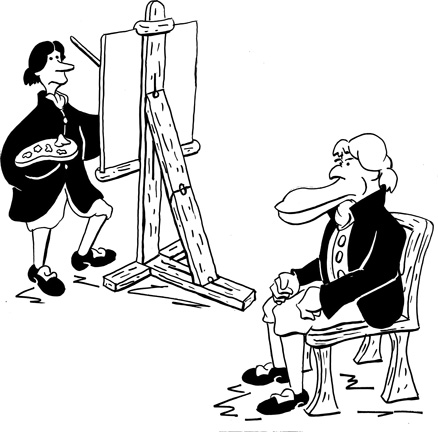
Constrained Expression
All in all, though, George could have looked worse. In fact, in some portraits he did look worse. There is another of Gilbert's portraits which shows George's face puffing up like a balloon. But this was actually a copy based on the Athenaeum portrait, and the excessive puffery is most likely due to Gilbert's (or an assistant's) haste in its execution rather than George sporting a particularly ill-fitting set of teeth.
Bulging cheeks and lips were not the only problems George had and his teeth were one of the reasons the the 600 or so guests that stopped by Mount Vernon each year were never greeted with a bright Presidential smile. You would think the dentures would take care of that, and we have records that some people complained that their dentures were too white.
That was hardly George's problem. Once Dr. Greenwood, upon receiving a set that George sent for adjustment, wrote back that the teeth were "quite black" and hypothesized that George was either drinking port wine or soaking his teeth in it. John suggested to make the teeth "more yellow" George should soak them in broth or some hard liquor.
Despite George's requests for tooth brushes, cleansing solutions, and scrapers, it was all in vain. When he became President, he had only one tooth left and that was used mostly to help anchor his dentures. That tooth finally went sometime in 1796.
A number of George's false teeth are still extant, although one set was swiped from the Smithsonian in 1981. People who look at them - including a full set made for George which is on display at Mount Vernon - wonder if it was really possible for George to put those massive, spring-operated monstrosities into his mouth and still manage to talk. Well, yes and no. Put them into his mouth he did, but how well he could talk is questionable.
In his younger days and in a social setting, George could be quite chatty - "downright impudent" as one lady said, qualifying that it was an impudence that she liked. However, not all of the ladies found the General's "impudence" amusing and there was one time George's (probably well-meaning) familiarity with a lady led to an embarrassing scene. But as time went on, George's taciturnity became more marked and his change from the dashing bon vivant military officer to reserved and taciturn statesman may have been due to the increasing problems with his constantly aching gums and chafing dentures.
The science of dentistry, though, was making some advances. The earliest advertisement for creating form fitted dentures "at a distance" appeared in 1787 when George was 55. The procedure was more or less the same we use now, although the molds today are made from aglinate - a sodium derivative from seaweed - and the casts and dentures from modern resin plastics. But for George the procedure was to soften beeswax by heating and then push the wax against the gums. When the wax cools and hardens you had the "negative" of the gums and hard palate. These could be sent on to the dentist would would make a positive cast from plaster of Paris and then make the form fitted dentures from the positive.
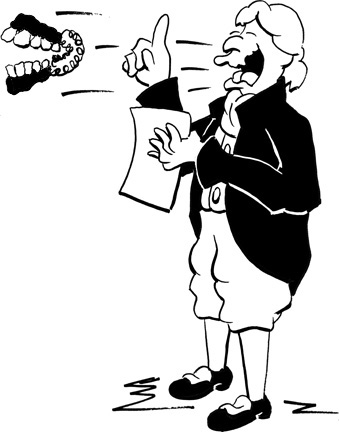
Mercifully brief.
Today, of course, near perfect fitting is possible from dental impressions by using acrylic resins. However, George's dentures were fashioned from materials that had to be shaped and carved by hand, ivory and metal being the materials of choice. Although porcelain - which can be molded - was being used for dentures by the early 1770's, it also chips easily and shrinks when fired. It wasn't until the mid 19th century that gutta percha - a naturally occurring rigid latex - became available for everyday items (Bat Masterson specified gutta-percha handles for his revolvers). Gutta-percha dentures began showing up in the early 1800's, and added some additional comfort for the wearer. George, though, never had the porcelain or gutta-percha option and his dentures hardly look form fitting.
OK, so how did George keep his teeth in place? Well, they were held fast by little springs - tightly coiled wires which were little cousins of the Slinky. You had two springs with each end attached toward the back and on either side of one of the plates. So when the dentures were placed in the mouth, the springs formed a loop trying to push the uppers and lowers apart. This forced the bases against the gums, but the drawback was that if you relaxed your jaw muscles, then your mouth would pop open.
So it took some practice to speak with any normalcy. At first you'll have spoken with a lisp but fortunately that problem generally didn't last. But for all his practice with dentures, George had a tendency to hiss as he spoke, a problem shared by Vincent Van Gogh with his dentures (yes, Vincent had false teeth). But the spring-powered teeth could also fly out during conversation. Perhaps that's why George's second inaugural address was the shortest on record - 192 words and taking perhaps a minute and a half to deliver. Mercifully brief, not only for the listeners, but also for George.
References
The Excruciating History of Dentistry: Toothsome Tales and Oral Oddities from Babylon to Braces, James Wynbrandt, St. Martin's Press, 2000. A general history of dentistry which does not get too technical.
"How It Evolved: Dental Impressions", Richard A. Glenner, DDS, Chairside Magazine, http://www.glidewelldental.com/chairside-magazine/volume9-1/history-dental-impressions.aspx
"Around The World: A Fascinating History Of False Teeth", GLEBE Dental Group, http://www.glebedental.com.au/news/around-world-fascinating-history-false-teeth/
Mount Vernon, http://www.mountvernon.org. Great website about a great place to visit! If you're in the vicinity of Washingon, D. C., make sure you pay George's old home a visit, even if it means passing up some other touristy attractions.
Among the specific pages about George's dental health are:
- "The Trouble with Teeth", http://www.mountvernon.org/george-washington/the-man-the-myth/the-trouble-with-teeth/. A series of specific points about George and his teeth.
- "False Teeth", William Etter, http://www.mountvernon.org/research-collections/digital-encyclopedia/article/false-teeth/. About (obviously) George's false teeth.
"George Washington - A Dental Victim", Barbara Glover, The Riversdale Letter, Summer/Fall, 1998.
The Writings of George Washington from the Original Manuscript Sources, 1745-1799, John Fitzpatrick, Frank Grizzard, Jr., http://etext.virginia.edu/washington/fitzpatrick/. Despite the trumpeted new editions of George's letters, this remains the most easily accessible and useful website for the serious armchair historian. Sadly, though, it isn't being maintained and some of the links to footnotes, no longer work. However, doing a search on "tooth" or "teeth" will bring up the correspondence with George's dentists. But be careful, some farm equipment such as harrows also had "teeth".
General and Mrs. Washington: The Untold Story of a Marriage and a Revolution, Bruce Chadwick, Sourcebooks, 2006.
George Washington, Spymaster: How the Americans Outspied the British and Won the Revolutionary War, Thomas Allen, National Geographic Children's Books, 2007. Children's books? Well, yes, this is a great book for the kids, but also for the adults. Despite his dental problems, George was a great spymaster, something that isn't always evident from other biographies.
"General Washington and His Walnuts", A.J. Schenkman, The Valley Forge Table, Issue 50, (June-August 10), 2001
"The Surprising George Washington", Richard Norton Smith, Prologue Magazine, Spring 1994, Vol. 26, No. 1, National Archives and Records Administration, 1994.
"George Washington: First in War, First in Peace, and First on the Dance Floor", American History Magazine, April, 2014. About George's embarrassing encounter with a young lady - probably more of a misunderstanding than anything else.
His Excellency: George Washington, Joseph J. Ellis, Vintage, 2004. Has a bit about George's teeth.
George Washington: A Biographical Companion, Frank E. Grizzard, Jr., ABC-CLIO Ltd, 2002
"Washington's False Teeth Taken from Smithsonian", The Bulletin, June 20, 1981. Is nothing sacred?
Gilbert Stuart, Carrie Barratt and Ellen Miles, Metropolitan Museum of Art, 2004.
The Crossing, Howard Fast, William Morrow, New York, 1971. As far as the Author of CooperToons can determine, this book has the earliest report of George's famous quote to Henry Knox. We must also remember that this book is a novel, yes, a novel, and there seems to be nothing before this that even hints about George requesting Henry to shift that fat ass. So the author of CooperToons has sadly concluded that despite its widespread acceptance by the readers and writers of the Fount of All Knowledge as irrefutable history, this is certainly a quote that George never made.
Toulouse-Lautrec: A Life, Julia Frey, Weidenfeld and Nicolson, London, 1994. Mentions Vincent's false teeth.
The Century Dictionary and Cyclopedia, The Century Company, New York, 1911. Gives us the formula Greenough's Tincture.